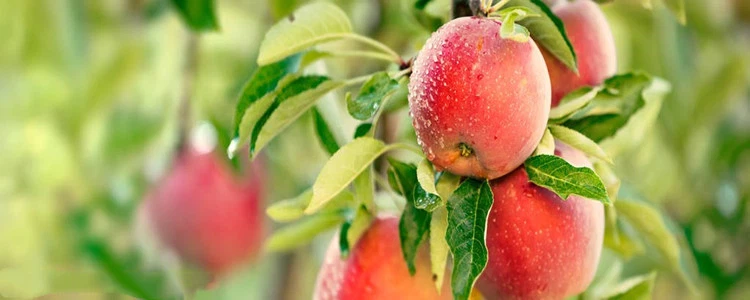About Apple
1. Brief Introduction
Apple(Malus pumila Mill.) are deciduous trees. Generally, trees can be as high as 15 meters, but cultivated trees are only about 3-5 meters high. The trunk is grayish brown, and the bark falls off to a certain extent. The flowering period of apple trees is determined based on the climate of different regions, but it is generally concentrated in April and May. Apples are cross-pollinated plants, and most varieties can not bear fruit from their own flowers.
Generally, apples will not bear fruit until 2-3 years after planting. The fruit is generally red, but it depends on the variety. The fruit of the apple tree is rich in minerals and vitamins and is one of the most commonly eaten fruits. The length of the fruit growth period is 65-87 days for early maturing varieties, 90-133 days for medium maturing varieties, and 137-168 days for late maturing varieties. Under normal circumstances, apples can have a life span of 15-50 years after planting.

2. Morphological characteristics
Apple trees are arbors, up to 15 meters high, mostly with round crowns and short trunks; Branchlets short and thick, cylindrical, densely tomentose when young, old branches purple brown, glabrous; Winter buds ovate, apex obtuse, densely pubescent.
The leaf blade is elliptic, ovate to broadly elliptic, 4.5-10 cm long and 3-5.5 cm wide, the apex is acute, the base is broadly cuneate or round, the edge is blunt serrate, when young, both surfaces are pubescent, and when grown, the upper surface is hairless; Petiole stout, about 1.5-3 cm long, pubescent; Stipules herbaceous, lanceolate, apex acuminate, entire, densely pubescent, caducous.
Corymb, with 3-7 flowers, gathered at the top of twigs, pedicels 1-2.5 cm long, densely tomentose; Bracts membranous, linear-lanceolate, apex acuminate, entire, tomentose; Flowers 3-4 cm in diameter; Calyx tube densely tomentose outside; Sepals triangular lanceolate or triangular-ovate, 6-8 mm long, apex acuminate, entire, both inner and outer surfaces densely tomentose, sepals longer than calyx tube; Petals obovate, 15-18 mm long, with short claws at the base, white, pink when in bud; Stamens 20, filaments uneven in length, about equal to half the petals; Style 5, lower part densely covered with gray-white hairs, slightly longer than stamens.
The fruit is oblate and spherical, with a diameter of more than 2 cm. The apex is often raised, the calyx is depressed, the sepals are persistent, and the fruit stalks are short and thick. Flowering in May and fruiting in July and October.
3. Growth habit
Apples can adapt to most climates. It is the best choice for apple growth between 35-50 degrees north and south latitude. Apple needs 1000-1600 units of heat and 120-180 days of frost-free weather. Warm days, cold nights, and as much light radiation as possible are the prerequisites to ensure excellent quality. Apples can resist frost at minus 40 ° C. During flowering and seed setting, if the temperature is between - 2.2 ℃ and - 3.3 ℃, the yield will be affected. Compared with other deciduous crops, apples blossom later. Therefore, the probability of suffering frost is reduced. However, for some varieties and regions, the frost effect is more obvious, so an effective frost resistance system is necessary. It is most suitable for pH 6.5, neutral, and well-drained soil.
The nutritional value of apples
1. Vitamin C: Apple is rich in vitamin C. Vitamin C is the protector of the cardiovascular system, and also has a certain whitening effect.
2. Appleol: Apples also contain a very special substance - malic phenol. Appleol has many effects. First, it can resist oxidation and keep food fresh; Second, it can effectively prevent tooth decay; Third, it can inhibit the rise of blood pressure and prevent hypertension; Fourth, it can inhibit the production of melanin and enzymes; Fifth, it can eliminate oral odor.
3. Malic acid: There are 17 kinds of amino acids in apples, including 7 kinds of amino acids that are necessary for the human body but cannot be synthesized by the human body. The tannin and various kinds of fruit acids contained in apples can help food digestion and accelerate the nutrient absorption of the human body.
4. Pectin: The pectin contained in apples can regulate the blood sugar level of the body, prevent the sudden rise and fall of blood sugar, and promote the emission of harmful substances such as lead and mercury in the body.
Efficacy and function of apple
1. Quenching thirst and moistening the lungs: apples are rich in vitamins, which can protect the respiratory tract and prevent respiratory infection. The crisp and juicy pulp has the effect of promoting fluid production and thirst quenching.
2. Prevention of gallstones: A few apples a day can prevent gallstones. Eating apples can reduce the cholesterol content in the blood, and increase bile secretion and bile acid function, so it can avoid cholesterol precipitation in bile to form gallstones.
3. Protect teeth: apples can protect teeth from cavities and gingivitis, and help prevent periodontal disease. According to the experiment, if an apple is eaten in 15 minutes, the organic acid and fruit acid in the apple can kill 99% of the bacteria in the mouth.
4. Relieve the mind and help sleep: Apple has the effect of nourishing the brain and blood, calming the mind, and sleeping. The aroma of apples is a good medicine for treating depression and depression. After many tests, experts found that among many odors, the aroma of apples has the greatest impact on people's psychology, and it has a significant role in eliminating psychological depression. Scientific experiments have proved that after patients with mental depression smell the aroma of apples, their mood will be greatly improved, their spirit will be relaxed and happy, and their sense of depression will disappear. In addition, patients with insomnia can smell the aroma of apples before falling asleep, which can make people fall asleep quickly and quietly.



